First published July 2018 | Words and photos by Vietnam Coracle
This post was last updated 6 years ago. Please check the comments section for possible updates, or read more on my Updates & Accuracy page.
INTRODUCTION | GUIDE | MAP | RELATED POSTS
In the misty forests that once covered the slopes of the B’lao mountains, the young Buddhist monk, Thích Nhất Hạnh, came to build a retreat in the late 1950s. Together with several good friends, Nhat Hanh bought some land in Vietnam’s Central Highlands from a local hill tribe, and began to work on a simple Buddhist retreat, including a library and a meditation forest. A few years later, Nhat Hanh wrote longingly and beautifully about his beloved retreat, while teaching at Princeton and Columbia universities in the United States, a world away from the lush, damp, tiger-stalked forests of his native Vietnam. Nhat Hanh named the retreat Phương Bối (‘Fragrant Palm Leaves’), a reference to the talipot leaves on which the earliest Buddhist teachings were written. Nhat Hanh, who recently passed away aged 95, was the revered founder of Plum Village mediation centre, in southern France. He was forced to abandon Phuong Boi, and left Vietnam in the mid-1960s, due to increasing hostility from political and religious groups for his outspoken but peaceful views. Reading Nhat Hanh’s collected journals from the early 1960s, I wondered if Phuong Boi was still there: it is.

Phuong Boi (Fragrant Palms Leaves) was a retreat established by the Buddhist monk, Thich Nhat Hanh
[Back Top]
GUIDE: PHUONG BOI HILL & FOREST
Address: Đồi Phương Bối, Dai Lao Commune, Lam Dong Province, Vietnam [MAP]
Directions: near the intersection of Le Thi Rieng & Truong Dinh lanes, north of Highway QL20
*Please note: Historical information in this article is based on my own reading & conversations with people. I have tried to be as accurate as I can with the information available to me.
If you have read Thich Nhat Hanh’s journals (collected in the volume called ‘Fragrant Palm Leaves’), then you will most likely want to see Phuong Boi for yourself, because he describes it in such poetic detail. However, a visit to Phuong Boi isn’t for everyone. There’s not much left of Thich Nhat Hanh’s original retreat: just a couple of structures and several trees planted by the monks. Indeed, even the forest is threadbare. Unless you have a particular interest in the history of Vietnamese Buddhism, there’s no reason to go out of your way to visit Phuong Boi. But, Phuong Boi is easily reached off Highway 20, the main road between Saigon and Dalat, and therefore makes a straightforward and quick excursion if you’re journeying between the two cities.
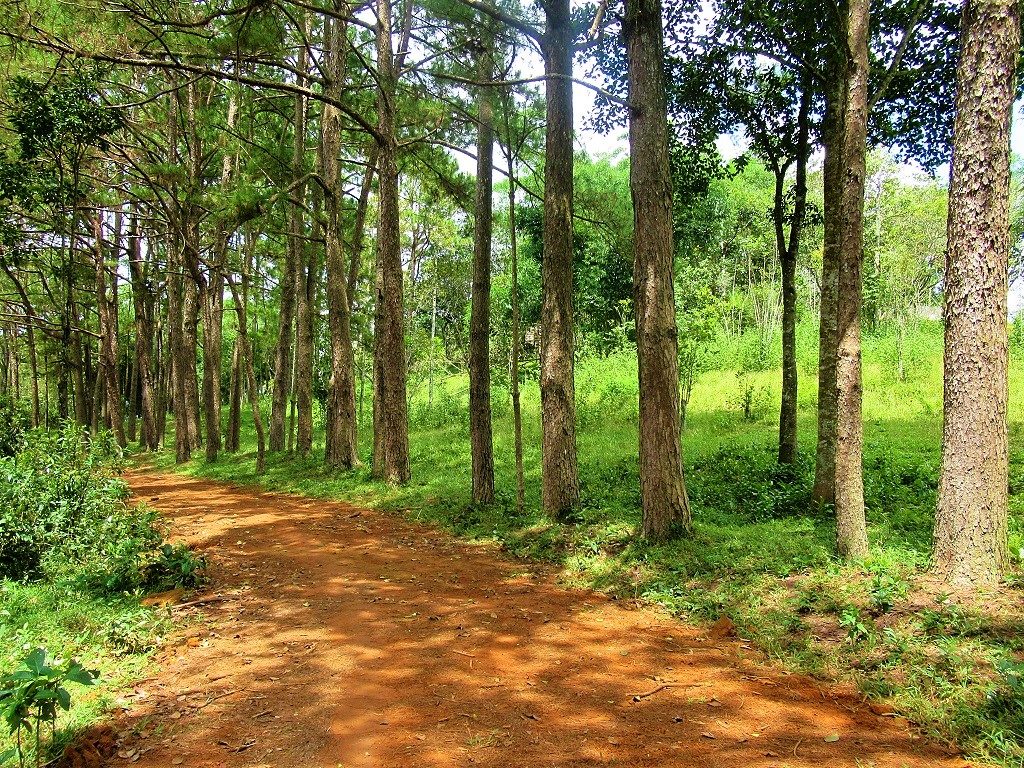
Thich Nhat Hanh’s time at Phuong Boi is vividly described in his journals, ‘Fragrant Palm Leaves
Apart from the history and associations with the now world-famous Thich Nhat Hanh, there’s also a certain pathos about Phuong Boi today. Where once a group of young Buddhist monks set out to create a peaceful, educational, and spiritual retreat in the abundant and attractive natural setting of the Dai Lao forest, (which echoed to the sound of birdsong and was home to Indochinese tigers, among other large and impressive wildlife), now the forests have all but disappeared, cleared for lumber and to make way for plantations of cash crops, such as tea and coffee, which stretch to the horizon in all directions. And, as with the trees, many of the animals have disappeared too, victims of over-hunting and loss of habitat. The small clump of pine trees on the hilltop at Phuong Boi is practically all that remains of the great forests that Thich Nhat Hanh used to stroll through, contemplating the marvels of nature and the richness of his homeland, and how they contrasted with the current political and social instability across the nation.


Phuong Boi was a sort of spiritual retreat for Nhat Hanh & friends: a place to study, write & meditate
There’s pathos, too, in the fact that, these days in Vietnam, there’s a religious building boom: monasteries, temples, churches, pagodas, and shrines are going up all over the nation, from the cities to the countryside. And yet, no one visits Phuong Boi, a site that was founded by, and meant so much to, Thich Nhat Hanh, who is surely Vietnam’s most widely-known and respected spiritual figure. The view across the undulating landscape from Phuong Boi looks out over church spires and pagoda rooftops, and, in the mountains on the opposite side of Highway 20, thousands of young Vietnamese flock to visit the impressive, hilltop Zen Buddhist temple of Chua Linh Quy Phap An. Meanwhile, Phuong Boi sits alone and unvisited, with agriculture encroaching on all sides.
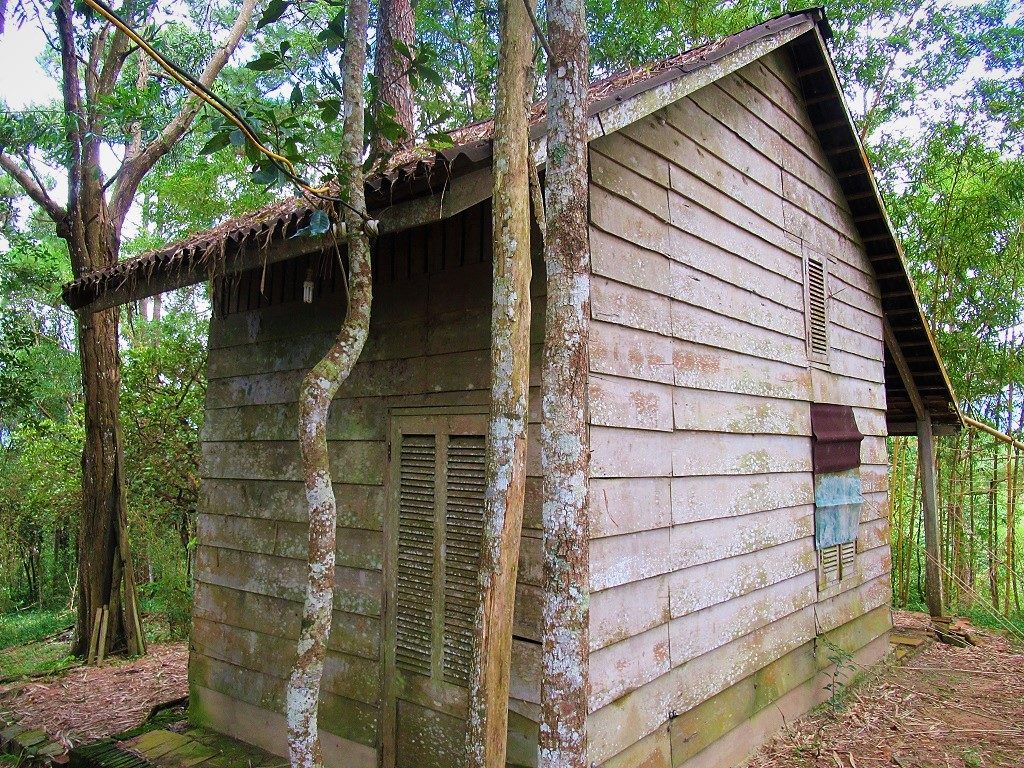
There’s not much left at Phuong Boi, just a couple of wood-plank cabins & a pleasant canopy of trees
Other sites associated with famous Vietnamese figures, whether living or dead, thrive as places of pilgrimage. But, I was told by Mr Yên, a man who has apparently lived at Phuong Boi for all of his 41 years, that people rarely visit. Many of my Vietnamese friends are admirers of Thich Nhat Hanh, yet none of them, as far as I know, have made the pilgrimage to Phuong Boi, which Nhat Hanh founded more than 60 years ago. There are no signposts to Phuong Boi and nothing to announce your arrival. A gravel lane leads steeply up the hill from Highway 20 – through tea, coffee and sugar cane plantations, and orchards of banana plants, jackfruit and durian trees – until it reaches a small pine forest opposite a Catholic cemetery. From here, dirt paths lead into the pine trees to a cluster of small structures (the route can be very muddy and slippery in wet conditions).

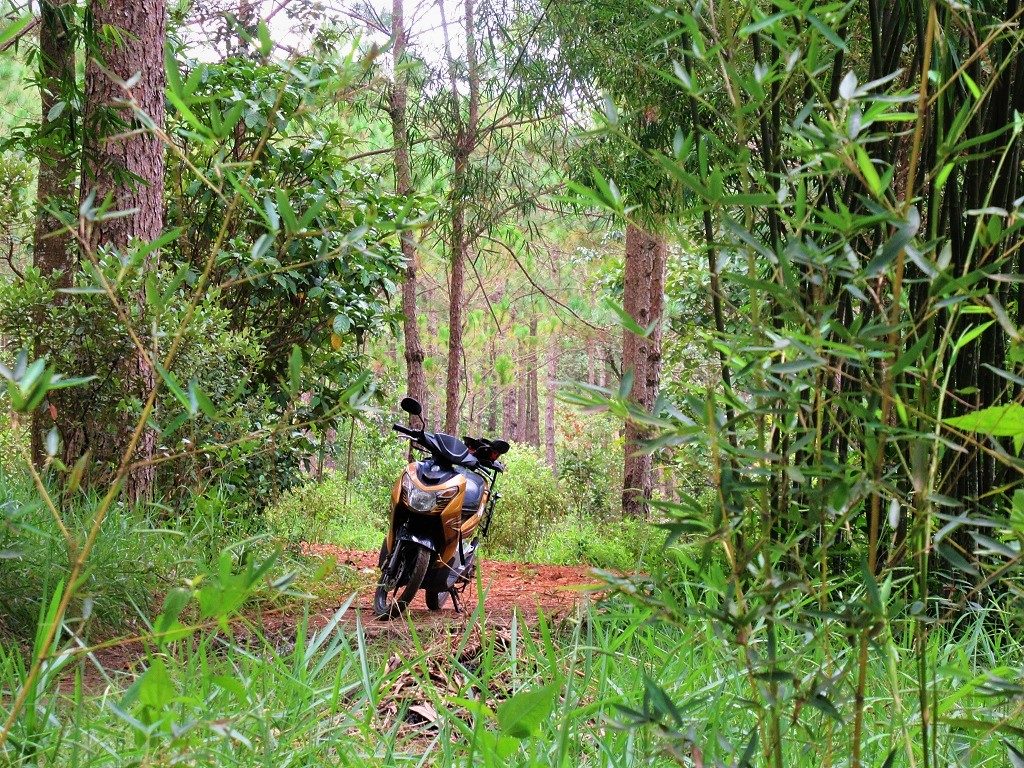
The road to Phuong Boi is unmarked, going from a gravel lane to a dirt path through the forest
A corrugated iron-roofed lodge is home to Mr Yên (whose name means ‘peace’) and several other people, all of whom wear grey or brown robes, indicating novice or ordained monks respectively. Pathways wind up the small hill to a couple of attractive stone and wood-plank cabins in the trees. When you visit, Mr Yên or some one else may show you around and talk a bit about the history of Phuong Boi. My Vietnamese was insufficient to make the most of what was being said. But I gathered that a large pine and a gnarly franipani bush were among the trees planted by Thich Nhat Hanh during his time here, and parts of the current structures belong to that period also.
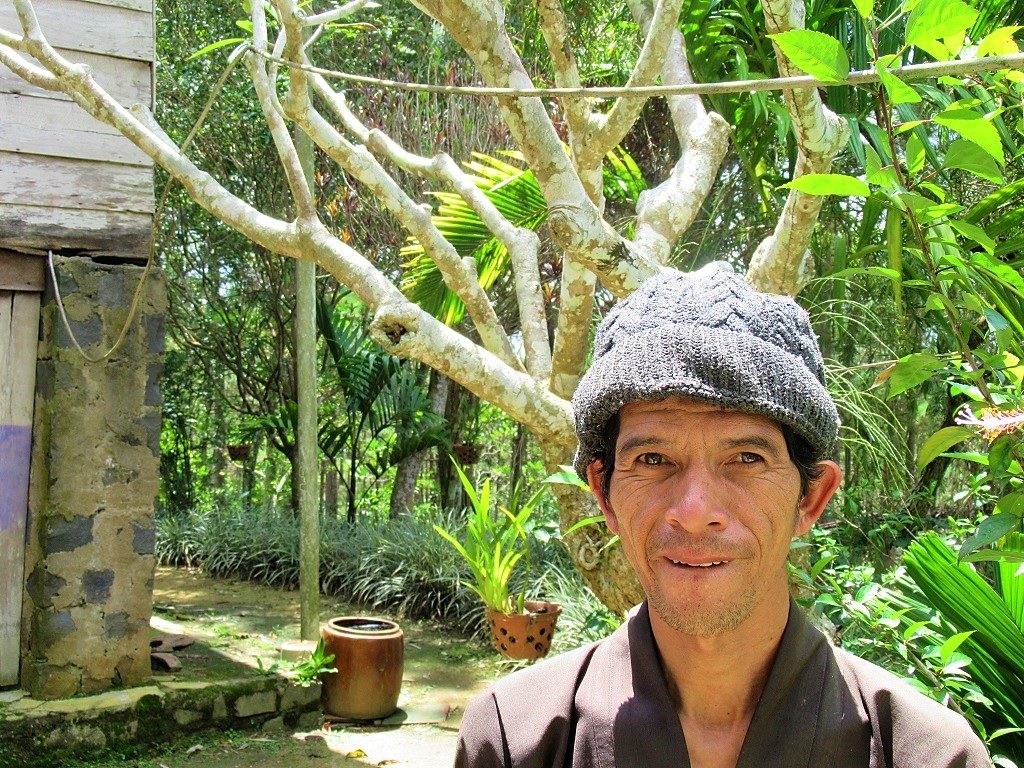
Mr Yên has lived on Phuong Boi hill all his life: he may show you around the trees & cabins
It’s a peaceful and contemplative setting: it’s not difficult to imagine the affect Phuong Boi must have had of the young Buddhists monks, as they sat meditating and studying and walking and writing and sleeping in the forest here. Large clumps of bamboo arc over the cabins, scratching the wooden-plank walls in the gusts of wind that come whispering through the pines. Hibiscus flowers bloom and elephant grass grows profusely between the tall pine trunks.

*Note: It’s possible to camp in the pine forests at Phuong Boi, but previous campers have left their mark with picnic trash: is nothing sacred?
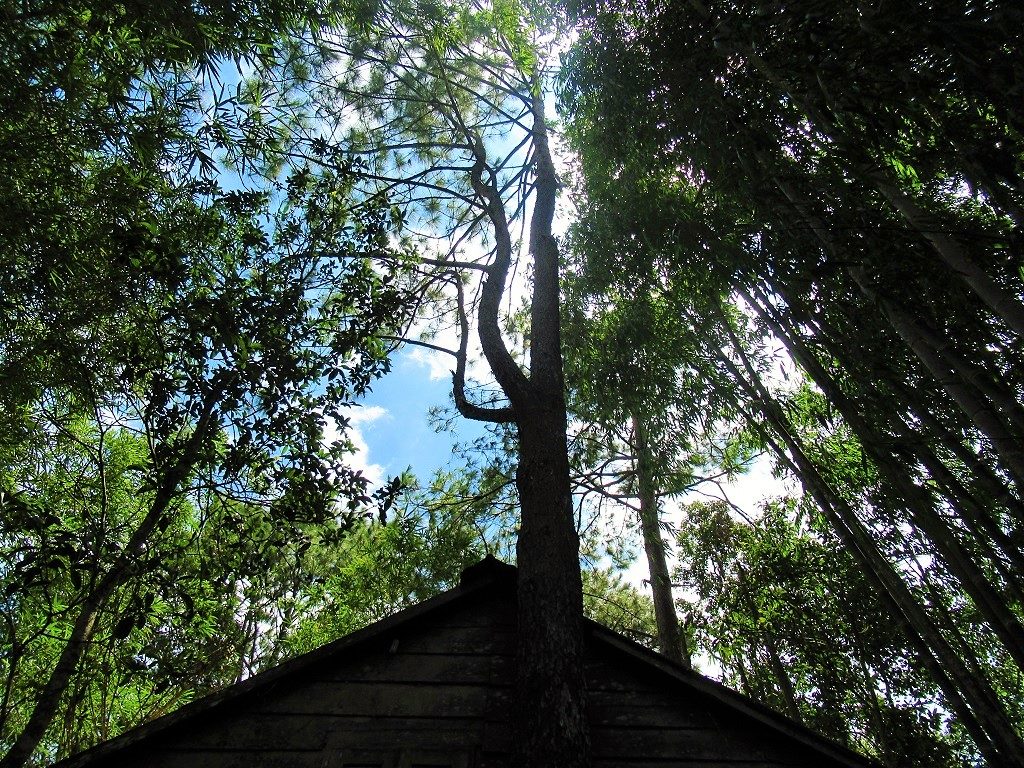
Phuong Boi is still a quiet & contemplative place, with large pines, tropical fruit trees & flowers
Sitting drinking oolong tea and nibbling candied ginger with Mr Yên after walking around Phuong Boi, it’s impossible not to feel nostalgic and a little sad about this place. In the valley below, concrete roofs protrude from the acres of coffee plantations, and the sound of honking horns, as juggernauts roar by on Highway 20, reaches our ears. Over the decades since Phuong Boi was first established, the area has undergone massive transformations. The landscape around Phuong Boi suffered, no doubt, during the war, but it was in the 1990s, when Vietnam’s coffee production started in earnest, that the forests began to be cut down. The agriculture here is on a huge scale: hardly a tree from the original forests has been left standing, and the traffic on the highway is constant. I’m not suggesting this feeling of sadness is particularly rational or meaningful, after all, even Thich Nhat Hanh and his friends cut down the forests, to some extent, to build their Buddhist retreat here, and again to make way for their own little tea plantation. But when you think that, just 60 years ago, the monks could walk on this very same ground and see the footprints of wild tigers in the mud, it’s difficult not to feel that something has been lost. Thich Nhat Hanh was forced to leave Phuong Boi, but he flourished elsewhere, and now resides in Plum Village, in the Dordogne. The tigers and the trees, however, have gone forever.

The vast forest that Thich Nhat Hanh (and tigers) used to walk through is now coffee plantations
Disclosure: I never receive payment for anything I write: my content is always free and independent. I’ve written this guide because I want to: I’m interested in Phuong Boi and I want my readers to know about it. For more details, see my Disclosure & Disclaimer statements here
[Back Top]
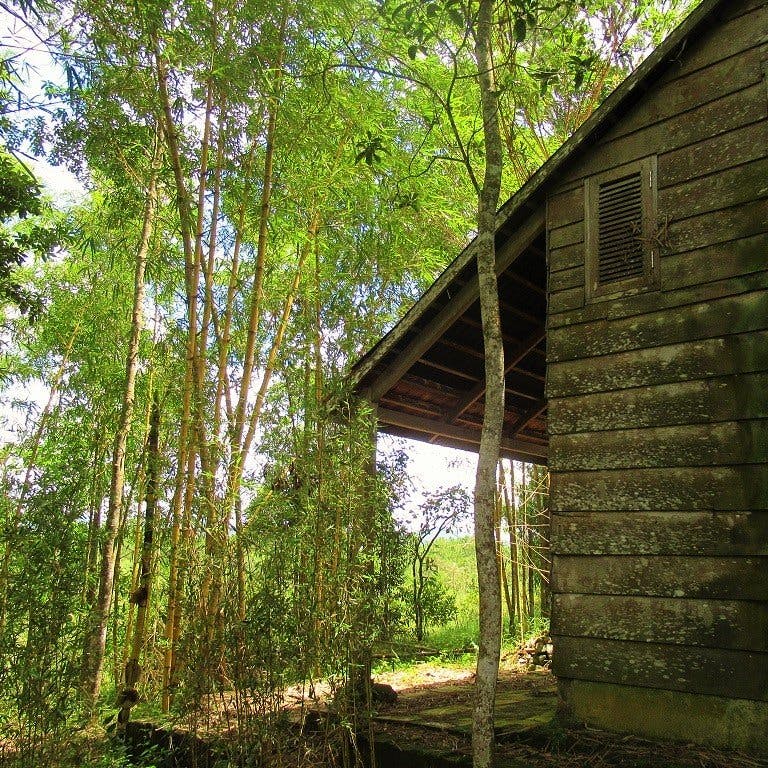
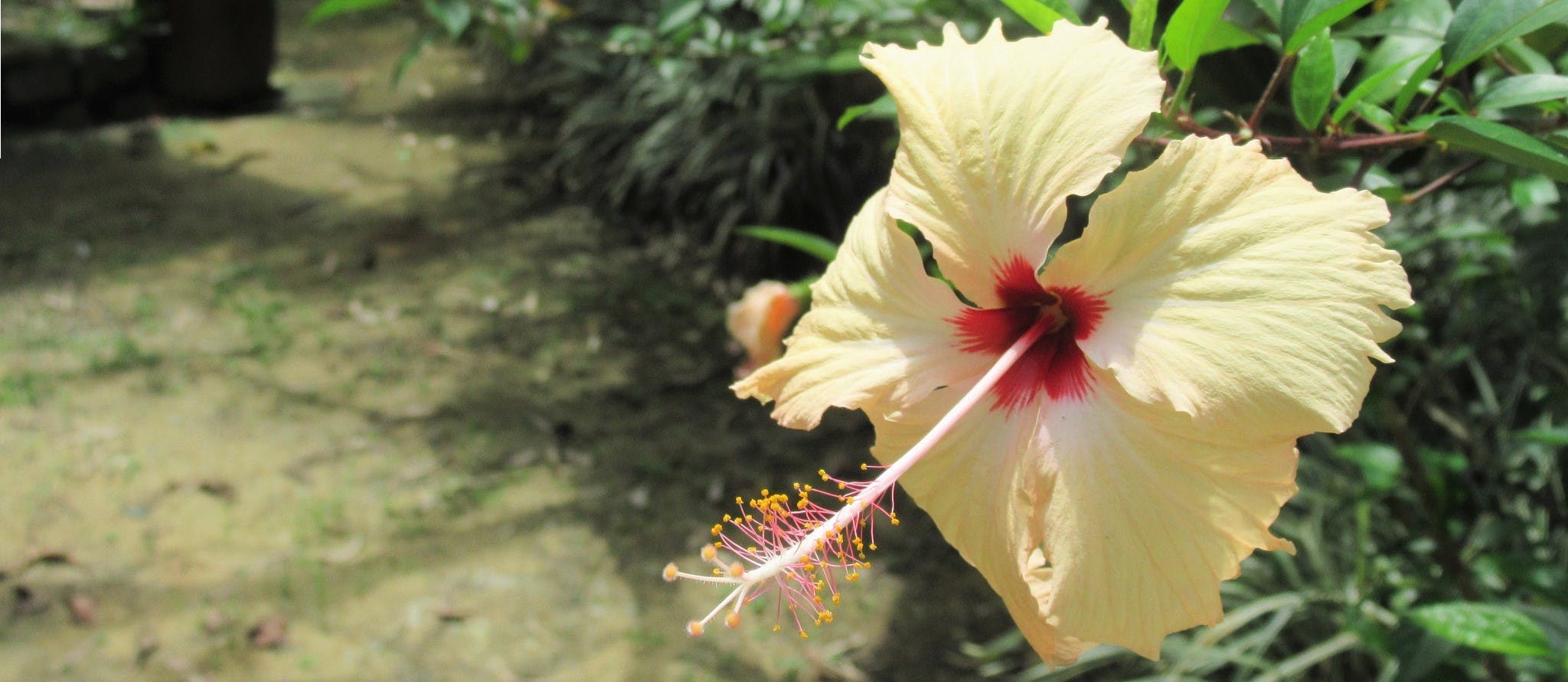
Somewhere within Thich Nhat Hahns writings he says that one of the reasons given to justify his exile was that he was a landowner. (phuong Bois) I had always assumed it was his visits to the US to try and end the Vietnam war. He did revisit before leavi g Vietnam to find Phuong Bois dilapitated. I think he and the monks had toeavd because of fighting between N & S Vietnamese.
Hi Anne,
Yes, I think there are myriad reasons why Thich Nhat Hanh left Vietnam. But he is now back living in Vietnam, which is great.
Tom
Visited today. Yên lying on the hammock behind new hut came over talked mainly about modern world crises and value differences between western and Asian societies. Tea was mixture of medicinal leaves sweet and smoothest ever tried lol. Was about to leave when he asked if i was vegetarian, and followed up by inviting me for lunch over at the home. His mother was still finishing up cooking as we arrived as she’s been tending to sick husband so Yên took me up to see Thầy’s wooden hut on the hill. The water storage was built by hand by Thầy and yes the frangipani and biggest pine tree planted by him as you mentioned. Lunch was delicious and over conversation his mother told me her own fascinating story. Her own mother was stealing weapons from the French to supply the Việt Minh. I think she was caught and ended up with a Crench authority figure and subsequently gave birth to Yên’s mother. She then pointed at Yên and said (in Việt) ‘see him, looks like half cast doesn’t he’. I then noticed a distinct set if French features i hadn’t put my finger on earlier – brown eyes for one. Yên’s father returned to France and set up another family, her Vietnamese mother died. She was then raised by an ‘uncle’ who was high up in the big Tibetan pagoda in Bình Dương which i visited only recent for the new moon. Apparently he knew everything about her being con lai but kept it secret to others. She moved to PB right after Liberation in 75 and been there since. Yên is 42 (in VN years). The meal was fantastic. More tea back at Yên’s new hut and i was pointed to a new road that descends closer to the white fence straight to the highway. Mum was very excited and proud of her new road, excitedly exclaiming how hard it used to be (i came up the old gravel road behind a tip truck!) compared to now. Thanks for the tip Tom.
Hi Luke,
Thanks for sharing this. I’m glad you had a pleasant experience at Phuong Boi Hill. What a fascinating story. It must be so rewarding to have a level of Vietnamese language which allows you to have discussions such as this.
I hope you enjoy the rest of your travels,
Tom
You’re welcome Tom. Very pleasant, lovely folks. Annie is an incredibly kind lady and great vegan cook too ^^
Re the Vietnamese, immersion is key.. Months pass without English so it’s more acquisition than attrition lol
Thanks as always for the great guides
G’day Tom,
this was the second place I decided to check out after nam cat tien, when figgering out the next part of the route and coming across this article. I had never heard of him. But wanted to see that retreat and what was left of it. Right away I saw Mr Yen sitting in the grass with two other men. I recognized him and stopped. We had a short chat. I pointed at a newly build small house, that was his build house. There was a wedding shooting done and some teens making photo across from us, as its scenic place. I had to drive down the path to reach the two old remaining wooden houses (and a new house where the current family lived who took it over from Thay Nhat Hanh). There, after seeing the remainings of the retreat (of which one house was from the master) I got invited for tea and sat there and talked with Ms Khe, sister of Mr Yen, while enjoying the peace from the forest. She had come over from Saigon. It was interesting to hear and understand more about the place. And yes as beautiful and peaceful as it is, a slight saddening feeling arises, while realizing what has happened. Though the plantations didnt bother me as that is beautiful greenery to me as well.On the way out I was some fruit offered from Mr Yen and he told me to come back. I said I will come with my friend from Bao Loc (who hadnt even known about this hill) so she could translate some more.
Anyway worthwhile a visit for anyone who passes by and wants to enjoy some beauty and peace of the pine forest retreat on the hill.
Thanks again for the great tip Tom!
Hi Tim,
Thanks for sharing your experience visiting Phuong Boi. Sounds like you had a pleasant time and I’m glad you got to meet and have a chat with Mr Yen.
I think it’s strange the site isn’t visited more often my followers of Thich Nhat Hanh – but there’s also a Buddhist monastery not far away that he founded which, I think, is still open.
Tom
Namaste, this is nour amini I would like to join your monastery and live this beautiful experience in arriving to veitnam in June may I know more information please about the program?
Hi Nour,
I don’t run any programs for visiting or staying at Phuong Boi. But you can follow the guide and map on this page to visit the site yourself.
Best,
Tom
Thank you for making the trip to Phuong Boi.
I guess Thay didnt visit PB again is because he already lived PB in his heart and the book vividly. Plum Village and everywhere he calls home with his Shanga.
With love and gratefulness for the present moment.
May bliss and health and fulfilling moments be with you.
Hi Vy,
Thank you. Yes, it’s amazing the reach and impact that Thich Nhat Hanh has had, not just in Vietnam, but across the world.
Tom
I wonder if it still owns by Thay Thich Nhat Hanh, does anyone know?
Hi Emmy,
I don’t know for sure, but I think it’s very unlikely.
Tom
Hi Tom,
I grew up reading Thich Nhat Hanh’s book Nẻo Về Của Ý about Phương Bối Am; I still reread it occasionally in the US to find peace and part of my youth and sometimes I wonder what had happened to the place, probably no longer exist or other people already took over it. So happy that it or part of the ruin is still there. Thanks for the discovery. I don’t go to Bảo Lộc (Lâm Đồng) or Đà Lạt direction often whenever I come back to Việt Nam but next time I will and check it out.
Best,
Don
Hi Don,
Great to hear you read and reread Nẻo Về Của Ý. Yes, it’s still there – quite different from how Thich Nhat Hanh describes it, but there’s still an atmosphere there. I hope you get a chance to visit next time you’re in the area.
Tom
Hi Tom,
We went to B’lao Xe Re last week and I wish we knew about this place by the time we were there. Thank you for the interesting information, we will visit in our next trip to Bảo Lộc
Hi Thuy,
Thank you. I hope you get a chance to go back soon and visit Phương Bối next time.
Tom